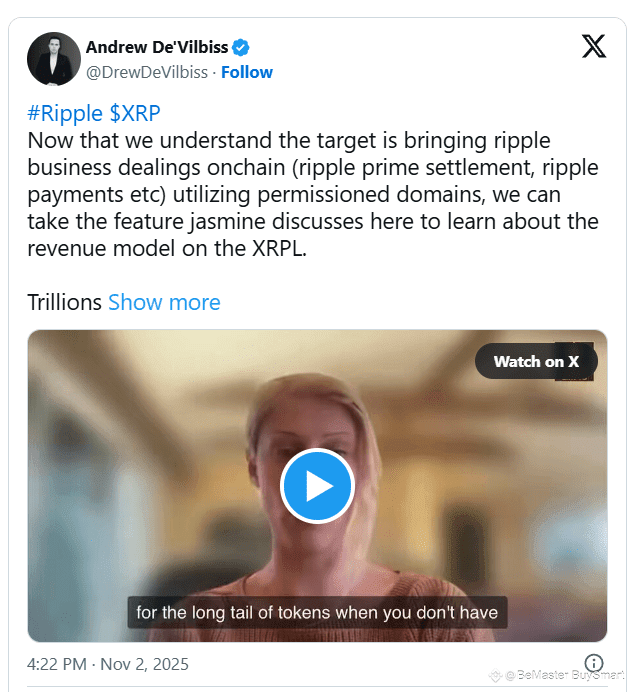$XRP The landscape for XRP is evolving rapidly. No longer is the conversation solely about speculative gains. Instead, we are seeing a concerted shift towards institutional settlement infrastructure, on-chain liquidity pools, and compliance-ready rails that could translate to recurring revenue and utility.
Importantly, much of this trajectory was outlined by Jasmine Cooper of Ripple Labs and amplified by Andrew De’Vilbiss’s commentary posted on X.
👉Institutional rails and settlement volumes
Cooper emphasizes the importance of professional market makers engaging alongside user-provided liquidity. As she puts it: “When you don’t have professional market makers that are supporting the market, and they are also for a yield opportunity for token holders if they’re willing to supply their liquidity for functionality of protocol.”
The implication is clear: scale requires both institutional and community-backed liquidity working in tandem. Amplified by KYC-compliant pools, the goal is to channel large-value flows through the XRP Ledger (XRPL). De’Vilbiss notes this is not theory, it is “the target” and “what’s happening”.

👉Hybrid execution: AMM meets order book
Cooper also outlines the XRPL’s hybrid model for trade execution:
“AMMs were an interesting concept that we wanted to expand XRPL DEX with, and we did so in a unique way where the two work in an interconnected fashion. So if you, as a user, know an executed trade order, the system under the hood will decide, you will get a better price if the AMM solves for that or the order book solves for that.”
In other words, the ledger decides whether an Automated Market Maker (AMM) pool or the traditional order book provides superior pricing. This hybrid routing is tailored for institutional-style flow where best execution, minimal slippage, and liquidity depth matter.
👉Revenue model via on-chain settlement and fees
The big picture: trillions in value servicing corporate, treasury, cross-border, or tokenized-dollar flows could be routed through permissioned XRPL domains. Each settlement generates micro-fees and enriches the ecosystem.
As these flows grow, utility for XRP as a liquidity rail and settlement asset expands. Cooper remarks: “All about bootstrap, organic adoption.” The emphasis on organic growth rather than yield-farm gimmicks underlines a long-term mindset.
👉Why this matters for investors
For XRP investors, the implications are profound. A utility-driven token anchored in real-world settlements shifts the narrative from speculative to fundamental. If XRPL becomes the rails for tokenized dollars and institutional pools, upward pressure on XRP’s utility and demand is credible.
The key triggers to monitor include TVL (Total Value Locked) in XRPL AMMs, institutional flow volumes to permissioned pools, and revenue capture from settlement fees. According to De’Vilbiss’ framing, this is the manifestation of the target.
In conclusion, by spotlighting Jasmine Cooper’s remarks, Andrew De’Vilbiss brings clarity to Ripple’s strategic aim: to bring settlement flows on-chain under KYC, fee-bearing, and anchored to XRPL infrastructure.
What we are witnessing is not just progress, but purposeful alignment between product, revenue model, and utility. For XRP stakeholders, the shift from “what could be” to “what is” demands attention.
🚀🚀🚀 FOLLOW BE_MASTER BUY_SMART 💰💰💰
Appreciate the work. 😍 Thank You. 👍 FOLLOW BeMaster BuySmart 🚀 TO FIND OUT MORE $$$$$ 🤩 BE MASTER BUY SMART 💰🤩
🚀🚀🚀 PLEASE CLICK FOLLOW BE MASTER BUY SMART - Thank You.
